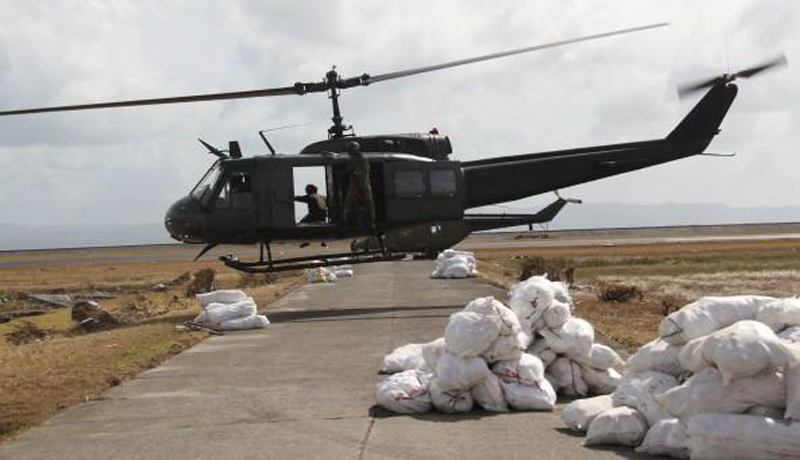
During the Cold War, Soviet aircraft were a top concern for the Philippine Air Force until 1990. That’s when Moscow decided to redeploy its MIG-23 fighters and TU-16 bombers which until that time had been stationed at Vietnam’s Cam Ranh Bay.
Today, Russian aircraft could become part of the Philippine Air Force. The mainstay of Philippine rotary-wing airlift at present is the UH-1H “Huey” helicopter. Many date to the Vietnam War (most were mothballed in the U.S. before transfer to the Philippines). Manila is looking for a generational replacement for an aerial workhorse which has served them for decades. Japan, Russia, the United States, Poland, Canada and Turkey have all played, or wish to play, a role in this unfolding procurement drama.
Manila is searching for new defense industry partners as China’s power continues to rise. The Unites States and the Philippines remain allies under a 1951 mutual defense treaty. However, President Rodrigo Duterte, has pursued a foreign policy aimed at balancing relationships in the Indo-Pacific area. For example, the Philippines is considering the purchase of 16 Russian Mi-17 helicopters. The Russian aircraft are cheaper than American alternatives, but U.S. sanctions on Russia could make the deal impossible.
Duerte has made two state visits to Russia, most recently in October, to discuss this and other potential defense ties. At the same time, Japan is another country where Duerte has sought to build new relations and is already playing a role in Philippine ambitions regarding military helicopters.
Under, Duerte, Filipino-Japanese ties have blossomed as both countries share concerns over China’s territorial ambitions. Duerte initially sought accommodation from China but, has increasingly undertaken a more hawkish approach to Beijing’s occupation of territory that was awarded to the Philippines in a 2016 ruling by the Permanent Court of Arbitration.
Duerte is even closer to Abe than he is with Putin. In the last three years, Duerte has made three separate trips to Japan to cement ties.
“Japan and the Philippines is a model not only for defense but economic cooperation,” says Armando Heredia, an analyst, focused on Asian security affairs,” Going back as far as the first two years of the Duterte Administration, there was always strong consideration for Japanese firms and agencies to help close some of the priority “Build Infrastructure” projects touted by the newly elected government, such as Railways and rural development in Duterte’s home region of Mindanao.”
The quality of the Russian defense industry remains high but the economic relationship between the two nations remains minimal though with some historical precedent — Aeroflot maintained a business relationship in the Philippines during the Cold War. Conversely, Japanese and Filipino economic interests are converging.
“Japan, motivated by concerns over rising labor costs, technology theft, and investment threats in mainland China, has shifted its focus to Southeast Asia under the “China Plus One” strategy. The Philippines, among the world’s most promising emerging markets, has in recent years become the leading destination for Japanese manufacturing investments in the region,” said Richard Javad Heydarian a Research Fellow at National Chengchi University (Taiwan) in a report for CSIS.
This year Japan donated some $96 million worth of helicopter parts to the Philippines which will help keep its fleet of 80 Huey helicopters in the air. Indeed Manila announced in October that seven such helicopters had returned to active service due to Japan’s provision of new spare parts.
“Bottomline, it is unclear whether the Fillipino-Japanese closer defense collaboration will help diffuse the tension in the West Philippine Sea or not,” said Rosauro Angelo Rodriguez, a Filipino defense technology expert. “It it is clear that the said move weakens the perceived control of China on the West Philippine Sea.”
Japan is likely keen to head off a substantial defense deal between the Manila and Moscow. Conversely, Japan and Russia may both see efforts to increase the military capability of the Philippines as it relates to China as a win-win.
In June, the Philippines signed a contract worth US$241.4 million with PZL Mielec a Polish subsidiary of Lockheed Martin to deliver 16 Sikorsky S-70i “Black Hawk” combat utility helicopters. That deal comes after the government of Canadian Prime Minister Justin Trudeau cancelled an agreement in early 2018 which would have provided the Philippines with Bell 412EPI helicopters due to concerns over human rights abuses in the Philippines ongoing counter-insurgency efforts.
What this means for the Russian helicopter deal remains unclear. In order to deepen defense ties the first-ever Russian defense attache to Manila was posted this fall.
- No Russia Ukraine deal Without the US
- The Hi-Tech Traditionalist: Neo-Bolshevism Suffers A Setback In Britain But The Stakes Are Much Higher In America


4 comments
To editor: I think it is PLAY role, not PAY.
thanks
It’s Manila not Manilla.
Thank you for the correction